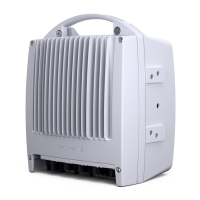MINI-LINKEandEMicro
3.4.2.4 Receive IF Signal Processing
The 140 MHz receive IF signal from the microwave sub-unit is amplified and fed
to the cable interface. Additionally, a portion of the signal is fed to a calibrated
detector to provide an accurate receiver input level measurement. The
measured level is accessible either as an analog voltage (AGC) at alignment
port or in dBm through the operation and maintenance system.
3.4.3 Microwave Sub-unit
3.4.3.1 DC/DC Converter
The DC/DC conver ter provides stable voltages for the microwave sub-unit as
well as for the radio interface unit.
3.4.3.2 Transmitter Block
Transmitter Oscillator
The frequency of the transmitter is controlled in a phase locked loop (PLL) (a
sample of the VCO signal is fed to a divider and further on to a programmable
phase detector). The error signal is controlled by the integrated control and
super vision system by using a serial bus. An unlocked V CO loop generates a
transmitter frequency alarm.
Multiplying and Filtering
The VCO signal is amplified, frequency multiplied and filtered.
Final Amplifier
The transmitter output power is controlled by adjusting the gain of the final
amplifier. The output power is set in steps of 1 dB through the operation and
maintenance system (Note: This applies to RAU1 15-E, 18-E, 23-E and 26-E
HP. RAU1 26-E and 38-E have a mechanical, adjustable attenuator adjacent
to the branching filter). The transmitter can be switched on or off by switching
the final amplifier.
Branching Filter
On the transmitting side, the signal is fed to the antenna through a branching
filter and a circulator. On the receiving side, the circulator feeds the received
signal to an input branching filter.
33
AE/LZT 110 2012 R8C 2002- 03-04

